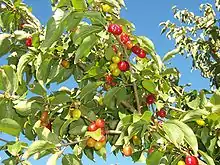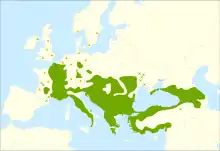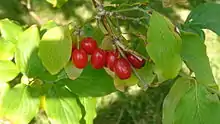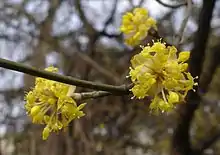Cornus mas
Cornus mas, the Cornelian cherry, European cornel or Cornelian cherry dogwood, is a species of flowering plant in the dogwood family Cornaceae, native to Southern Europe and Southwestern Asia.
| Cornelian cherry | |
|---|---|
 | |
| Branch with fruit | |
| Scientific classification | |
| Kingdom: | Plantae |
| Clade: | Tracheophytes |
| Clade: | Angiosperms |
| Clade: | Eudicots |
| Clade: | Asterids |
| Order: | Cornales |
| Family: | Cornaceae |
| Genus: | Cornus |
| Subgenus: | Cornus subg. Cornus |
| Species: | C. mas |
| Binomial name | |
| Cornus mas | |
 | |
| Distribution map | |
| Synonyms | |
|
Synonymy
| |
Description
It is a medium to large deciduous shrub or small tree growing to 5–12 m tall, with dark brown branches and greenish twigs. The leaves are opposite, 4–10 cm long and 2–4 cm broad, with an ovate to oblong shape and an entire margin. The flowers are small (5–10 mm in diameter), with four yellow petals, produced in clusters of 10–25 together in the late winter (between February and March in the UK),[1] well before the leaves appear. The fruit is an oblong red drupe 2 cm long and 1.5 cm in diameter, containing a single seed.
Uses
Fruit


The fruits when ripe on the plant bear a resemblance to coffee berries, and ripen in mid- to late summer. The fruit is edible, as used in Eastern Europe, UK,[1] and British Columbia, Canada,[2] but the unripe fruit is astringent. When ripe, the fruit is dark ruby red or a bright yellow. It has an acidic flavor which is best described as a mixture of cranberry and sour cherry; it is mainly used for making jam,[2] makes an excellent sauce similar to cranberry sauce when pitted, and then boiled with sugar and orange, but also can be eaten dried.
In Azerbaijan and Armenia, the fruit is used for distilling vodka, in Austria and German Alps is used for distilling Dirndlbrand, in Albania and Bosnia and Herzegovina it is distilled into rakia. In Turkey and Iran, it is eaten with salt as a snack in summer, and traditionally drunk in a cold drink called kızılcık şerbeti. Cultivars selected for fruit production in Ukraine have fruit up to four centimetres long. It is eaten in Eastern Europe in many ways including as a traditional medicine.
The fruit of C. mas (together with the fruit of C. officinalis) has a long history of use in traditional Chinese medicine in which it is known as shānzhūyú, 山茱萸 and used to retain the jing.[3]
Flowers

The species is also grown as an ornamental plant for its late winter yellow flowers, which open earlier than those of Forsythia. While Cornus mas flowers are not as large and vibrant as those of the Forsythia, the entire plant can be used for a similar effect in the landscape.
Wood
The wood of C. mas is extremely dense and, unlike the wood of most other woody plant species, sinks in water. This density makes it valuable for crafting into tool handles, parts for machines, etc.[4]
Cornus mas was used from the seventh century BC onward by Greek craftsmen to construct spears, javelins and bows, the craftsmen considering it far superior to any other wood.[5] The wood's association with weaponry was so well known that the Greek name for it was used as a synonym for "spear" in poetry during the fourth and third centuries BC.[5]
In Italy, the mazzarella, uncino or bastone, the stick carried by the butteri or mounted herdsmen of the Maremma region, is traditionally made of cornel-wood, there called crognolo or grugnale, dialect forms of Italian: corniolo.[6]
Name
Cornus mas, "male" cornel, was named so to distinguish it from the true dogberry, the "female" cornel, Cornus sanguinea, and so it appears in John Gerard's Herbal:
This is Cornus mas Theophrasti, or Theophrastus his male Cornell tree; for he ſetteth downe two ſortes of Cornell trees, the male and the female: he maketh the wood of the male to bee ſound as in this Cornell tree; which we both for this cauſe and for others alſo, haue made to be the male; the female is that which is commonly called Virga ſanguinea, or Dogs berrie tree, and Cornus ſylveſtris, or the wild Cornell tree, of which alſo we will intreate of in the next chap. following.[7]
Garden history
The shrub was not native to the British Isles. William Turner had only heard of the plant in 1548,[8] but by 1551 he had heard of one at Hampton Court Palace.[9] Gerard said it was to be found in the gardens "of such as love rare and dainty plants".[7]
The appreciation of the early acid-yellow flowers is largely a 20th-century development.[10]
Cultivars
The following cultivars have gained the Royal Horticultural Society’s Award of Garden Merit (confirmed 2017):[11]
References
- Nicholson, B. E.; Wallis, Michael (1963). The Oxford Book of Garden Flowers. London: Oxford University Press. ISBN 1131802403.
- Steve Whysall (5 October 2009). "Cornus mas". Vancouver Sun. Retrieved 18 December 2018.
- Schafer, Peg (2011). The Chinese Medicinal Herb Farm: A Cultivator's Guide to Small-scale Organic Herb Production. Chelsea Green Publishing. pp. 312 (page 150). ISBN 9781603583305.
- Demir, F.; Hakki Kalyoncu, I. (December 2003). "Some nutritional, pomological and physical properties of cornelian cherry (Cornus mas L.)". Journal of Food Engineering. 60 (3): 335–341. doi:10.1016/S0260-8774(03)00056-6.
The wood is heavier than water and does not float, therefore it is used for tools, machine parts, etc.
- Markle, Minor M., III (Summer 1977). "The Macedonian Sarrissa, Spear and Related Armor". American Journal of Archaeology. 81 (3): 323–339 [324]. doi:10.2307/503007. JSTOR 503007.
- "Il Buttero" (in Italian). Associazione Butteri d'Alta Maremma. Archived from the original on 8 March 2007.
- John Gerard (1597), The herball, or, Generall historie of plantes, Iohn Norton, p. 1282, doi:10.5962/bhl.title.99400
- Turner, The Names of Herbes, 1548; noted in Alice M. Coats, Garden Shrubs and Their Histories (1964) 1992, .s.v. "Cornus".
- Turner, A New Herball, 1551, noted in Coats.
- Coats (1964) 1992.
- "AGM Plants – Ornamental" (PDF). Royal Horticultural Society. July 2017. p. 16. Retrieved 24 January 2018.
- "RHS Plantfinder - Cornus mas 'Aurea'". Retrieved 2 February 2018.
- "RHS Plantfinder – Cornus mas 'Golden Glory'". Retrieved 2 February 2018.
- "RHS Plantfinder – Cornus mas 'Variegata'". Retrieved 2 February 2018.
![]() Media related to Cornus mas at Wikimedia Commons
Media related to Cornus mas at Wikimedia Commons